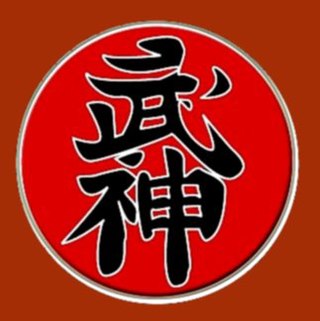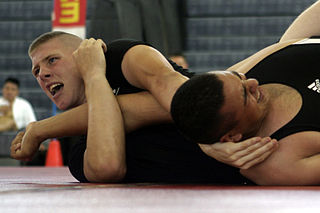
Judo is an unarmed modern Japanese martial art, combat sport, Olympic sport, and the most prominent form of jacket wrestling competed internationally. Judo was created in 1882 by Kanō Jigorō as an eclectic martial art, distinguishing itself from its predecessors due to an emphasis on "randori" instead of "kata" alongside its removal of striking and weapon training elements. Judo rose to prominence for its dominance over established jujutsu schools in tournaments hosted by the Tokyo Metropolitan Police Department, resulting in its adoption as the department's primary martial art. A judo practitioner is called a "judoka", and the judo uniform is called "judogi".

Kickboxing is a full-contact hybrid martial art and boxing type based on punching and kicking. Kickboxing originated in the 1950s to 1970s. The fight takes place in a boxing ring, normally with boxing gloves, mouth guards, shorts, and bare feet to favor the use of kicks. Kickboxing is practiced for self-defense, general fitness, or for competition. Some styles of kickboxing include: Full contact karate, Muay Thai, Japanese kickboxing, Lethwei, Sanda, and Savate.

The Bujinkan is an international martial arts organization based in Japan and headed by Masaaki Hatsumi. The combat system taught by this organization comprises nine separate ryūha, or schools, which are collectively referred to as Bujinkan Budō Taijutsu. The Bujinkan is most commonly associated with ninjutsu. However, Masaaki Hatsumi uses the term Budo as he says the ryūha are descended from historical samurai schools that teach samurai martial tactics and ninjutsu schools that teach ninja tactics.
Randori (乱取り) is a term used in Japanese martial arts to describe free-style practice (sparring). The term denotes an exercise in 取り tori, applying technique to a random succession of uke attacks.

Submission wrestling, also known as submission grappling, submission fighting or simply grappling, is a competitive martial art and combat sport that focuses on ground fighting and submission techniques. It is a hybrid discipline that incorporates elements of various grappling arts such as various wrestling styles, judo, and Brazilian jiu-jitsu. Submission wrestling is practiced both as a competitive sport and as a training method for self-defence and mixed martial arts (MMA).

Yoseikan budō (養正館武道) may be classified as a sōgō budō form, but is used here to indicate a martial art into which various martial ways have been integrated. It is probably most widely known for its descent from a pre-war style of aikido; however, it has important connections to judo, karate, western boxing, savate, and a traditional forms of Japanese combat known as gyokushin-ryū jujutsu and Tenshin Shōden Katori Shintō-ryū.
Hybrid martial arts, also known as hybrid fighting systems or sometimes eclectic martial arts or freestyle martial arts, referred to as mixed martial arts or fighting systems that incorporate techniques and theories from several martial arts. While numerous martial arts borrow or adapt from other arts and to some extent could be considered hybrids, a hybrid martial art emphasizes its disparate origins.
German Ju-Jutsu is a martial art related to traditional Japanese Jujutsu, developed in Germany in the 1960s using techniques from Jujutsu, Judo, Karate and various other traditional and modern martial arts. Its governing body in Germany is the DJJV. Its competitive sport aspects are coordinated internationally by the JJIF ; Ju-jutsu under JJIF rules is a part of the World Games and World Combat Games. The system is taught to the German police forces.
The Jitsu Foundation or TJF is a national-level association of sports clubs headquartered in the United Kingdom, but also has affiliated organisations in other countries around the world. Focusing on standing throws and locks using weakening strikes to assist, the style taught within the association is known as Shorinji Kan Jiu Jitsu(少林寺完柔術).

The Canon of Judo is a book that was originally published in 1956, and written by Kodokan 10th dan, Kyuzo Mifune (1883-1965). The book covers almost all of the Kodokan recognized techniques, adds variations and new techniques, including Do-Jime in passing as well. The book also describes fifteen Kata developed by Mifune to teach adaptation through reversal and counters. The book organizes the techniques differently from the official Kodokan Gokyo.
Jujutsu techniques include joint locks, chokeholds, strikes, grappling, throwing, and other self-defense techniques.

Kanō Jigorō was a Japanese educator, athlete, and the founder of judo. Along with ju-jutsu, judo was one of the first Japanese martial arts to gain widespread international recognition, and the first to become an official Olympic sport. Pedagogical innovations attributed to Kanō include the use of black and white belts, and the introduction of dan ranking to show the relative ranking among members of a martial art style. Well-known mottoes attributed to Kanō include "maximum efficiency minimal effort" and "mutual welfare and benefit".

Takeda Ryu Nakamura Ha is a gendai (modern) martial art developed by Nakamura Hisashi in the mid to late 20th century.
Fumon Tanaka is a traditional Japanese martial arts practitioner who holds a number of Soke positions in Japanese schools of martial arts. Specialising in various weapon forms and unarmed fighting methods. He is also an author and has appeared in numerous world media.

Jujutsu, also known as jiu-jitsu and ju-jitsu, is a family of Japanese martial arts and a system of close combat that can be used in a defensive or offensive manner to kill or subdue one or more weaponless or armed and armored opponents. It was coined by Hisamori Tenenuchi when he officially established the first school of jiu-jitsu in Japan. A subset of techniques from certain styles of jujutsu were used to develop many modern martial arts and combat sports, such as judo, aikido, sambo, ARB, Brazilian jiu-jitsu, and mixed martial arts.

The Ju-Jitsu International Federation (JJIF) is an international sport federation founded in 1998 after the expansion of the European Ju-Jitsu Federation (EJJF) for the propagation of the modern competitive sports version of Jujitsu, also known as Sport Ju-Jitsu.

W.A.K.O. World Championships 2007 in Belgrade were the joint 16th edition of the W.A.K.O. world championships - the second event would be held later that year in Coimbra, Portugal. They were for amateur male and female kickboxers and covered the following categories; K-1, Low-Kick and Light-Contact. Weight classes for men ranged from light bantamweight to super heavyweight, while the women's ranged from featherweight to super heavyweight. More information on the categories, weight classes and rules is provided in the various sections below. In total there were 1085 athletes at the championships, representing sixty countries including China, fighting in 49 tournaments. The Belgrade championships were held at the Pionir Hall in Belgrade, Serbia from Monday, September 24 to Monday, October 1, 2007.

W.A.K.O. World Championships 2007 in Coimbra were the joint 16th edition of the W.A.K.O. world championships and was the second event. The championships were for amateur male and female kickboxers and martial artists, covering the following categories; Full-Contact, Semi-Contact, Musical Forms and Aero Kickboxing. In the contact kickboxing categories, weight classes ranged from light bantamweight to super heavyweight. The Musical Forms and Aero Kickboxing categories did not have weight classes but had different forms. More information on the categories, weight classes and rules is provided in the various sections below. In total there were around 600 competitors at the event, representing fifty countries from five continents, competing in forty-three competitions. The Coimbra championships were held at the Pavilhão Multiusos de Coimbra in Coimbra, Portugal from Monday, November 26 to Sunday, December 2, 2007.
The United Society of Jujitsu Organizations is recognized by the Ju-Jitsu International Federation (JJIF) as the National Ju-Jitsu Member of the USA and as the governing body for Ju-Jitsu with JJIF. The JJIF is the recognized JuJitsu Organization to the Olympic Family World Games.

The rivalry between the Kodokan school of judo and the Totsuka school of Yoshin-ryu jujutsu happened in the 1880s during the Meiji Era in Japan. Consisting of several challenges and tournaments, its result saw the decline of the traditional jujutsu schools and the rise of judo as an institutionalized martial art. Although surrounded in controversy and legend because of inconsistent sources, it has been considered a vital part of the history of judo.











